| Brain
Structure |
Function |
Associated Signs and Symptoms |
|
Cerebral Cortex
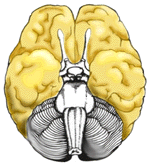
Ventral View ( From bottom)
|
The
outermost layer of the cerebral hemisphere which is composed
of gray matter. Cortices are asymmetrical. Both hemispheres are
able to analyze sensory data, perform memory functions, learn
new information, form thoughts and make decisions. |
|
| Left
Hemisphere |
Sequential
Analysis: systematic, logical interpretation of information.
Interpretation and production of symbolic information:language,
mathematics, abstraction and reasoning. Memory stored in a language
format. |
|
| Right
Hemisphere |
Holistic
Functioning: processing multi-sensory input simultaneously to
provide "holistic" picture of one's environment. Visual
spatial skills. Holistic functions such as dancing and gymnastics
are coordinated by the right hemisphere. Memory is stored in
auditory, visual and spatial modalities. |
|
|
Corpus Callosum

|
Connects
right and left hemisphere to allow for communication between
the hemispheres. Forms roof of the lateral and third ventricles. |
- Damage to the Corpus Callosum may result
in "Split Brain" syndrome.
|
|
Frontal Lobe
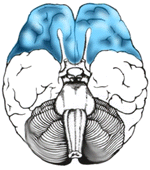
Ventral View (From Bottom)

Side View
|
Cognition and memory.
Prefrontal area: The
ability to concentrate and attend, elaboration of thought. The
"Gatekeeper"; (judgment, inhibition). Personality and
emotional traits.
Movement:
Motor Cortex (Brodman's):
voluntary motor activity.
Premotor Cortex: storage
of motor patterns and voluntary activities.
Language: motor speech
 Diagram Diagram
|
- Impairment of recent memory, inattentiveness,
inability to concentrate, behavior disorders, difficulty in learning
new information. Lack of inhibition (inappropriate social and/or
sexual behavior). Emotional lability. "Flat" affect.
- Contralateral plegia, paresis.
- Expressive/motor aphasia.
|
|
Parietal Lobe
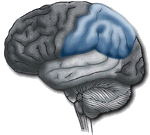
|
Processing of sensory
input, sensory discrimination.
Body orientation.
Primary/ secondary
somatic area. |
- Inability to discriminate between sensory
stimuli.
- Inability to locate and recognize parts of
the body (Neglect).
- Severe Injury: Inability to recognize self.
- Disorientation of environment space.
- Inability to write.
|
|
Occipital Lobe
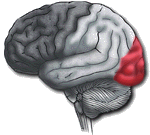
|
Primary visual reception
area.
Primary visual association
area: Allows for visual interpretation. |
- Primary Visual Cortex: loss of vision opposite
field.
- Visual Association Cortex: loss of ability
to recognize object seen in opposite field of vision, "flash
of light", "stars".
|
|
Temporal Lobe
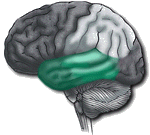
|
Auditory receptive
area and association areas.
Expressed behavior.
Language: Receptive
speech.
Memory: Information
retrieval.
|
- Hearing deficits.
- Agitation, irritability,
childish behavior.
- Receptive/ sensory aphasia.
|
|
Limbic System
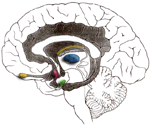
|
Olfactory pathways:
Amygdala and their
different pathways.
Hippocampi and their
different pathways.
Limbic lobes: Sex,
rage, fear; emotions. Integration of recent memory, biological
rhythms.
Hypothalamus. |
- Loss of sense of smell.
- Agitation, loss of control of emotion. Loss
of recent memory.
|
|
Basal Ganglia

|
Subcortical gray matter
nuclei. Processing link between thalamus and motor cortex. Initiation
and direction of voluntary movement. Balance (inhibitory), Postural
reflexes.
Part of extrapyramidal
system: regulation of automatic movement. |
- Movement disorders: chorea, tremors at rest
and with initiation of movement, abnormal increase in muscle
tone, difficulty initiating movement.
- Parkinson's.
|
![]()
